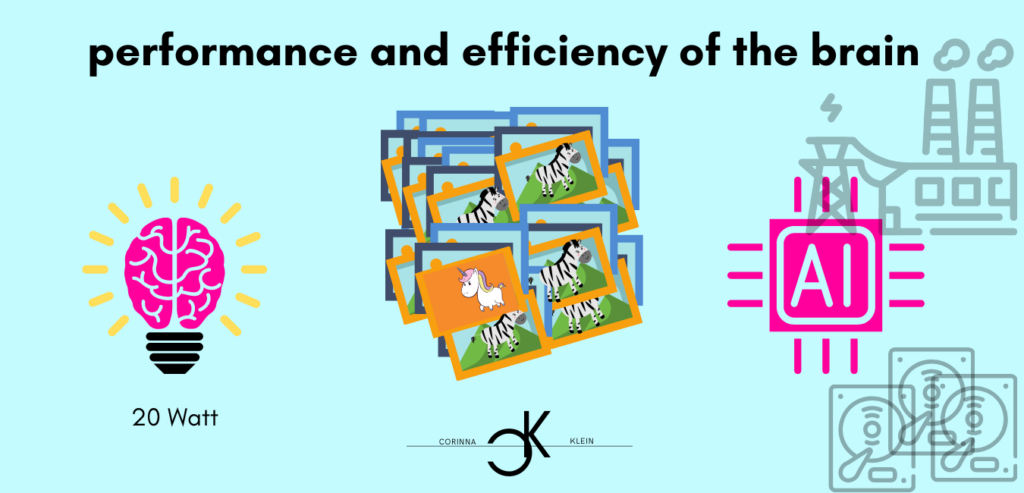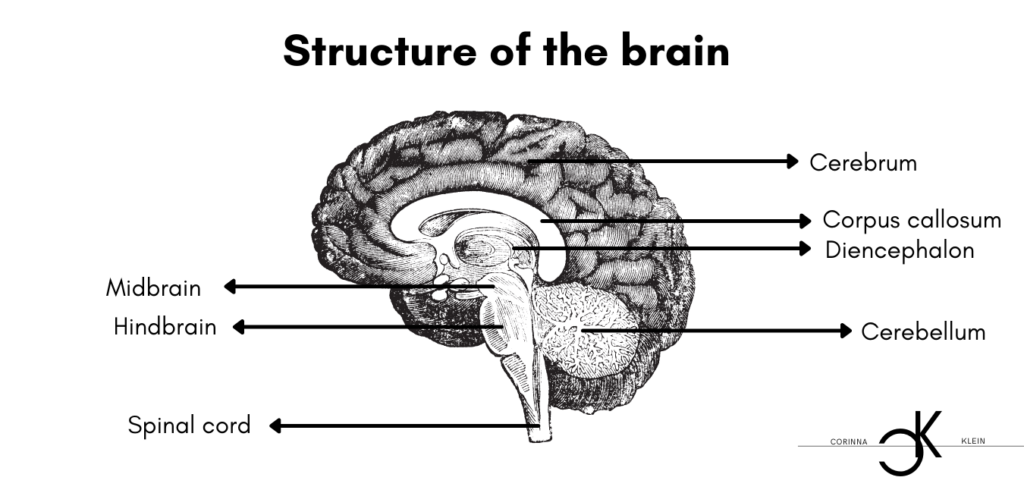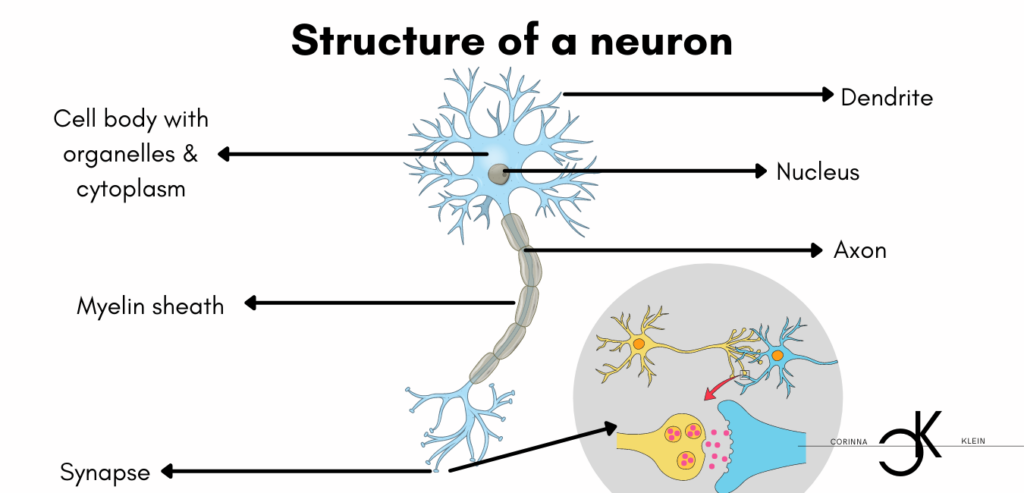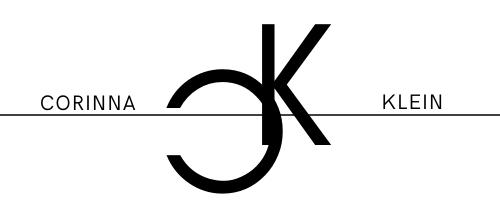We are constantly learning something new. Be it this text you are reading, playing an instrument, riding a bicycle, new names or phone number (do you still learn phone numbers nowadays?), processes, correlations, routes or languages. Our brain performs at its peak every day. All sorts of things come to our minds, we even have whole dialogues with ourselves. How does that work?
More efficient than any AI
Neurobiologically, a thought is a measurable pattern of activity in our minds. Let’s first look at the structure of our brain a bit more closely and come back to the thoughts later. The brain is located in our head, protected by the cranial cavity, and represents the control center of our body. It processes vast amounts of sensory perceptions, stores information, coordinates behaviors and also bodily functions. This requires an abundance of nerve tracts and nerve cells: about 90 billion nerve cells and about 5. 8 million kilometers of nerve tracts. This is actually an impressive length. Our neural pathways could be wrapped around the Earth more than 100 times. In addition to the appropriate cabling, however, some energy is also required. Although it only makes up about 2% of the mass, it is involved in up to 20% of the total energy consumption. In a newborn, energy consumption can increase to as much as half of the total consumption of the whole body. Our brain consumes 20 watts of energy, which is roughly equivalent to the power of a light bulb. That may sound a little meaningless. Maybe the following comparison helps to clarify the efficiency of our brain: An artificial intelligence is able to recognize a unicorn out of millions of other pictures with zebras. However, this requires a lot of energy in the form of large data centers that have to be cooled at great expense. Our brain accomplishes this capacity with 20 watts. If an AI had to perform as well as our brain, it would probably need its own power plants to supply it with the energy it needs. If you wanted to store all the information that our brain processes and stores on hard drives, you would need thousands of hard drives. So, the brain works incredibly efficiently. How does it accomplish this output?

Roughly speaking, it can be divided into five areas: cerebrum, cerebellum, diencephalon, midbrain and hindbrain. The cerebrum is the area of the human being that is most highly developed. It can be divided into two halves, which are connected by bars and these in turn into different brain lobes (frontal, parietal, temporal and occipital lobes). The surface of the cerebrum is highly folded and this folding is individual for each person. In the cerebrum lies, among other things, the speech center. Furthermore, cognitive processes are executed from here. The cerebellum can be divided into three further parts and takes care of balance, muscle tone and muscle movement, among other things. The diencephalon can be divided into four parts and is a kind of switching station and control center for many sensory and motor functions. The vegetative nervous system is controlled from here, as is the endocrine system. The pH, temperature, blood pressure and even the biological clock are also controlled from here. A lot of information arrives there and is passed on. The midbrain and afterbrain, with the brainstem, is the oldest part of our brain. Among other things, it is responsible for basic bodily functions such as consciousness and reflexes (for example, eyelid closure, swallowing, coughing reflex, eye movement, breathing or heartbeat).

In search of thoughts
After this rough overview, let’s zoom a little further into our brain and take a closer look at the cell types. Glia and nerve cells are found in the brain. Both play an important role in the functioning of the brain. For a long time, glial cells were only considered to have a supporting and holding function, but today it is known that they are also responsible for the transport of substances, the exchange of fluids and the electrical isolation of the nerve cells. They also play a role in other processes. In the search for the thought, one quickly comes across nerve cells, also called neurons. They are connected by synapses. In our brains, there are not only about 90 billion nerve cells, but also about 100 trillion synapses. The typical structure of a neuron consists of a cell body and cell branches that can branch out strongly and reach astonishing lengths of almost one meter. Apart from the peculiarities, nerve cells have the same structure as other cells (cell nucleus, plasma, cell organelles). The cell body has two types of branches: dendrites and neurites (or axons). Dendrites passively take up electrical stimuli, which spread over the cell membrane and are transmitted by axons. The stimuli or electric excitation is also called action potential. Often nerve cells are enveloped by a myelin layer, which isolates them and thus enables a better transmission of stimuli. If the excitation exceeds a certain threshold, the signal is amplified and can thus cover large distances within a short time. Thus, an impulse that warns of danger or triggers pain can whiz through our nervous system at speeds of up to 400 km/h. Nerve cells can either be connected with another nerve cell (via synapses) or with other specialized cells, e. g. of a muscle. Synapses, as contact points between nerve cells, make it possible for the stimulus to be transmitted, which happens either electrically or chemically. During chemical transmission, messenger substances (neurotransmitters) come into play. In reality, the system is once again much more complex, but for the time being, this insight is sufficient for us.

Is now a neuron equal to a thought?
It has been found that there are certain neurons that always become active at the sight of a photo of the person, at the sign of the name or at the sound of the voice. So the neuron was actually specialized to that person and not just their voice or face, but that is the exception. There is simply not the space in our brains for us to have specialized grandmother or object neurons for all persons and objects. For example, when we see a blue airplane in the sky, completely different impressions such as sounds, color, shape, and movement have to be processed and put back together into a thought or cognition. There are studies that show that several neurons can form a compound, be active at the same time, and sort of interconnect over it. These associations would then correspond to a perception, like a memory or a thought. So is a thought a synchronization of different networks of nerve cells? It is still not possible to make a final judgement on this matter. It is still unclear how these changing associations are organized and how they are connected. And how does a thought turn into action? To come back to our example with the blue plane, how does a thought become a motor process, a word? What is certain is that thoughts are chemical chain reactions and electrical stimuli that are active in oscillating compounds. However, much remains a mystery to be explored, and we must continue to think about it.


Very nice and interesting article, showing how complex our brain is. Impressive how efficient it is still against todays AI architectures. This makes me curious about this topic which holds so much to discover. I will start now to dive deeper into this field 🙂 Thx a lot.